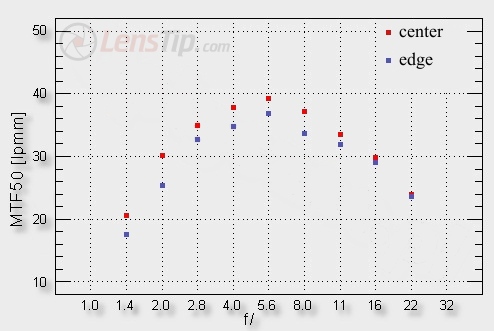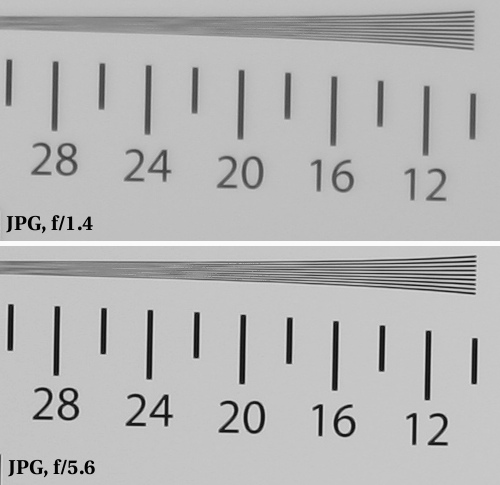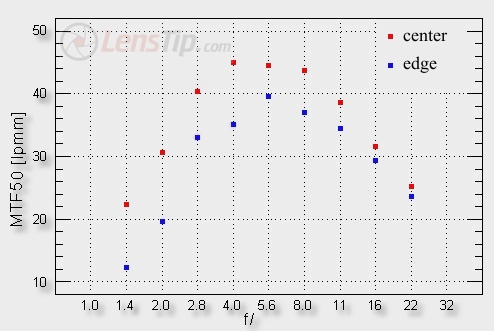Canon EF 50 mm f/1.4 USM
4. Image resolution

The first thing that sticks out is a weak result at the maximum relative aperture. The level of 20 lpmm is exceeded but just barely - it means the pictures, taken there, won’t be sharp for sure. Only on stopping down to f/2.0 we can go over the level of 30 lpmm and enjoy really good photos.
Please Support UsIf you enjoy our reviews and articles, and you want us to continue our work please, support our website by donating through PayPal. The funds are going to be used for paying our editorial team, renting servers, and equipping our testing studio; only that way we will be able to continue providing you interesting content for free. |
- - - - - - - - - - - - - - - - - - - - - - - - - - - - - - - - - - - - - - - - - - - - - - - -
There’s one more interesting thing. The best prime lenses, tested on the Canon 20D have maximum results about 42-44 lpmm. The EF 50 mm f/1.4 just brushes the level of 40 lpmm. It is not a fault, as the value of 40 lpmm means pictures of very high quality and the difference between 40 lpmm and 43 lpmm, although seen on the graph, is not so easily noticeable when it comes to real-life photos.
It seems that the key to understand the lack of record-breaking values in the frame center is the lens’s performance at the frame edge. The Canon 50 mm f/1.4 constructors sacrificed these several lpmm in the center to give us a lot better frame edge performance instead. The test results confirm this hypothesis. In the case of the APS-C sensor the difference between the frame center and the frame edge is really slight and it remains at the level of just several tiny lpmm in the whole apertures range. By f/5.6 the Canon reaches at the edge 37 lpmm so a value which is often difficult to exceed even for zoom lenses and in the frame center.
At the end of presenting the APS-C sensor performance a few picture crops. To begin with, conventionally, we publish our test chart crops saved in the JPEG format along with the RAW files, used for testing the resolution performance.
 |
Additionally, we would like to proudly present an interesting comparison. In our editorial office at the same time we had, apart from the tested Canon EF 50 mm f/1.4 USM, also a Sigma 50 mm f/1.4 EX HSM and a Zeiss Planar 50 mm f/1.4 T* on the Nikon mount. That latter was put on the Canon 20 D using an adapter which allowed us to arrange a direct scenes duel of all these three instruments. Its results are presented below.
| Frame center - f/1.4 | |||
|
|
|
|
|

|

|

|
|
| Frame center - f/2.8 | |||
|
|
|
|
|

|

|

|
|
Attempting to interpret these crops we can notice that the Zeiss fares the best, although its advantage over the Sigma is minimal. They outdistance the Canon very obviously.
Let’s pass to describing the lens’s performance on the full frame sensor of the Canon 1Ds MkIII. The appropriate graph is presented below.

The Canon 1Ds MkIII has the same pixels density than the 20D so the results from these cameras are easy to compare. It is worth remembering though that the 1Ds is a lot newer construction and its pixels work more efficiently so the MTF values, generated by it, are typically about 2 lpmm higher than in the case of the 20D.
Exactly that kind of performance can be observed for the frame center. The graph is an exact copy of the 20D results but about 2-4 lpmm higher. It’s a bit better than the typical distance between those cameras but you should consider the fact that the lens specimen, tested on the 1D, was different from that tested on the 20D – we can’t exclude the possibility of having a better lens version the second time. The differences between them are small and brush the values within the margin of measurement error.
The comparison between the old EF 50mm f/1.4 and the new Nikkor AF-S 50 mm f/1.4 is also an interesting thing. The latter is a bit better than the Canon at the maximum aperture, by f/2.0 both lenses perform very similarly and then the Canon reaches a tad higher results. All in all in the frame center both lenses fare very much alike.
When it comes to the full frame edge, you can express plenty of reservations about the f/1.4 performance which is simply very weak. Even on stopping down to f/2.0 we don’t see a significant improvement because we still obtain the values at the level of 20 lpmm. Only on further stopping down the results ameliorate by leaps and bounds. The Canon starts to achieve one of the higher values for this class devices. The level of 40 lpmm at the frame edge is really very high. For comparison: a very expensive EF 85 f/1.2L had the highest values at the full frame edge amounting to 34 lpmm. It confirms us in our belief that the EF 50 mm f/1.4 was constructed very meticulously to perform at the frame edge the best, even if it means a few lpmm less in the frame center. It can be understood in a way – on the full frame this lens is a standard which can be used for journalistic photos; in their case the sharpness kept at the same level across the whole frame is sometimes very useful. With a portrait 85 L lens the situation is different – the frame center sharpness results are outstanding but the edges – not. These blurred edges contribute towards an increase of small depth of field blur and can often suit a portrait photographer even better.






